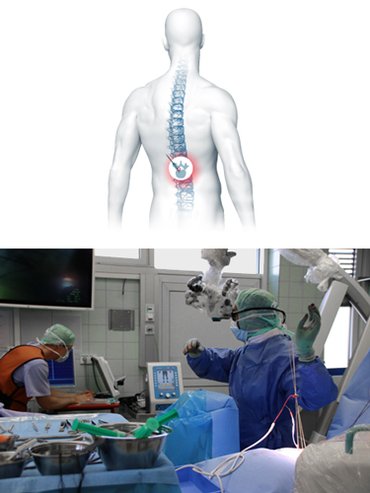In the spinal cord there are afferent and efferent nerve tracts, which enable the movements and sensations of our torso and limbs. Injuries to the spinal cord, which runs within the bony spinal canal, can therefore lead to far-reaching sensory disturbances and paralysis.
Surgical interventions on the spine >> without intraoperative neurophysiological monitoring are hardly conceivable in modern medicine. Thanks to the monitoring of the motor pathways by EMG/MEP >> and the somatosensory pathways by SEPs as well as by the direct stimulation of nerve roots, neuronal functions can be monitored during such an intervention.
The continuous monitoring of nerve functions with motor and somatosensory evoked potentials (MEPs and SEPs) during erection or stabilization of the spine significantly reduces the risk of postoperative dysfunction for the patient. Intraoperative neuromonitoring enables the surgeon to react directly to changes in nerve functions and to achieve a better result for the patient. The ISIS IOM System >> is designed for precisely these tasks and can monitor a variety of electrophysiological signals. SEPs, MEPs and EMGs can be derived intermittently or continuously.
For spinal tumour surgery in the cervical and upper thoracic spine, D wave recording is also possible. With this method, MEPs can be recorded directly from the spinal cord and further information regarding irritations can be collected to reduce the risk of functional deficits.
The C2 Xplore and its Spine Software >> combine all functions for precise and efficient neuromonitoring of pedicle screw placement. The system and the associated software offer an established and reliable aid for spine stabilization and are specifically designed to support the surgeon in implant placement. Nerve roots and the spinal cord are therefore safely protected and the risk of postoperative functional deficits is minimized.
In addition to the treatment of scoliosis and spinal stabilisation, intraoperative neurophysiological monitoring is also used for the following therapies:
